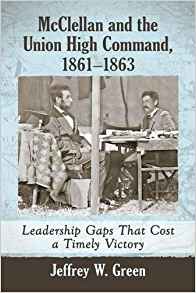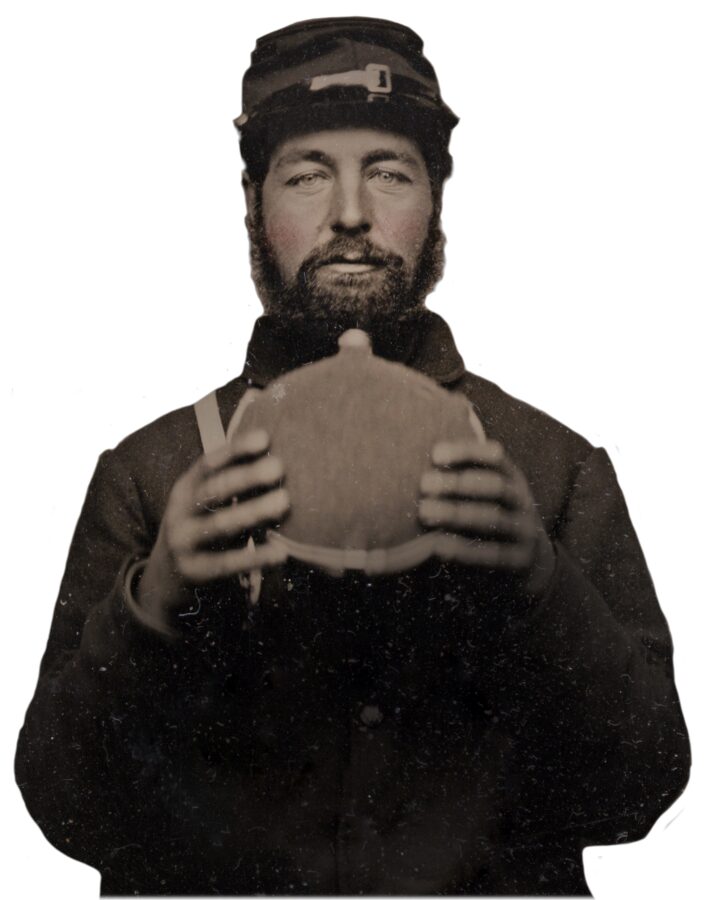McClellan and the Union High Command, 1861-1863: Leadership Gaps That Cost a Timely Victory by Jeffrey W. Green. McFarland, 2017. Paper, ISBN: 978-1476665733. $35.00.
 Union strategy and command structure has become the subject of increased study in recent years. Jeffrey W. Green’s McClellan and the Union High Command examines the development and creation of the Union high command from the generals’ perspectives, rather than focusing on Lincoln. Pushing back against the more traditional narrative of Lincoln “finding a general,” Green wants to use McClellan as a lens to understand the way the Union high command operated, failed, and learned during the early years of the war.
Union strategy and command structure has become the subject of increased study in recent years. Jeffrey W. Green’s McClellan and the Union High Command examines the development and creation of the Union high command from the generals’ perspectives, rather than focusing on Lincoln. Pushing back against the more traditional narrative of Lincoln “finding a general,” Green wants to use McClellan as a lens to understand the way the Union high command operated, failed, and learned during the early years of the war.
Green opens by summarizing the development of the professional military before the Civil War. Both the dual-army tradition and the smaller scale of previous conflicts did not adequately prepare the army or national government for the Civil War’s magnitude. Previous conflicts had also seen regular involvement from leading political figures, especially presidents, further complicating the command structure.
Once he begins discussing the war, Green focuses on the instability created by a lack of command structure. Lines of communication between the president, chief of staff, secretary of war, and army commanders was rarely clear or followed. Subordinates retained the ability to go outside of the theoretical chain of command and speak directly to political leaders. Green also highlights the inability of high command to create a coherent strategy and set of objectives for the war’s first two years.
Though he is not trying to rehabilitate McClellan, Green argues that the general was not solely responsible for the dysfunction that plagued high command. Lincoln and Stanton were never certain how much authority they wished to delegate to McClellan. Exacerbating this problem was the general’s inability to use what power he did have to lead the attacks they wanted. Partly because he did not trust McClellan, Lincoln removed him as general-in-chief right before the Peninsula Campaign without providing a replacement, further unsettling the command structure. Green’s harshest criticism involves McClellan not understanding the relationship between political and military goals. The general resisted sharing information with civilian leadership, and never accepted how rapid action could maintaining support for the war effort, critical in a democratic society. Worst of all, when it came time to fight battles, he lost.
McClellan also opposed the addition of emancipation to Union war aims. While McClellan is generally criticized for presumptuousness on this question, Green tries to situate his actions in prior experience. Officers had offered their opinions on political policy during wartime before. Why should this war be any different? Later that summer, Lincoln brought in both John Pope and Henry Halleck to change the war’s course, but Halleck proved unable (or unwilling) to effectively control those operations. Other works, particularly Albert Castel and Brooks D. Simpson’s recent Victors in Blue, are critical of Lincoln and Halleck’s inability to give direct orders. Green hints at this criticism, though does not make it directly.
Green follows McClellan’s time with a briefer recounting of the struggles of commanders who followed. Ambrose Burnside was regularly undermined by two different groups of commanders: the officers who wanted McClellan back, and Joe Hooker, who wanted the job for himself. Hooker reported directly to Lincoln, bypassing Halleck, and also had greater reign to reorganize the army, a signal of stronger command. Following his defeat, however, both Lincoln and the corps commanders quickly lost confidence in him. George Meade did have the benefit of a more structured command environment, but he also came recommended by the corps commanders he would lead. They had less reason to scheme against him. Oddly enough, Green does not mention Dan Sickles in all this, an interesting omission, given that he was a Hooker supporter and a notoriously troublesome subordinate.
Green’s omission of Sickles isn’t troubling by itself, but it does reflect one of the book’s weaknesses. Green’s review of the literature comes off as somewhat dated, even as his references are relatively up to date. Green begins the book by discussing the historiography of Union leadership, and claims that high command and strategy have been neglected. This is an odd complaint, given that he cites Donald Stoker’s The Grand Design in several places. While Green has nicely laid out the daily maneuvering and planning that characterized McClellan’s time in command, the scope of this study feels narrow at times. Other works provide wider and more comprehensive examinations of these larger issues across the war. For a tight view, though, on how these circumstances helped to undermine leadership and eventually prolong the conflict, Green has provided an interesting case study.
Dr. Keith Altavilla teaches history at Lone Star College, Cy Fair.
